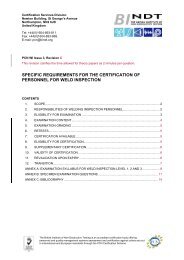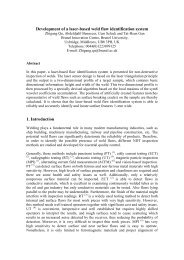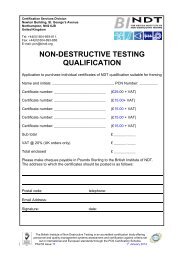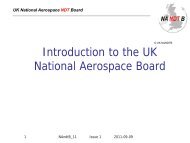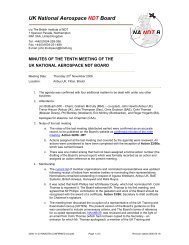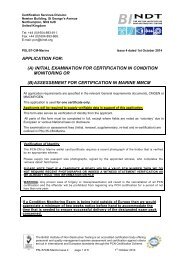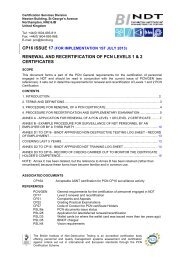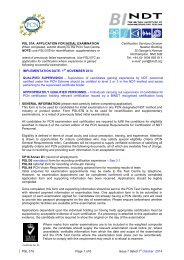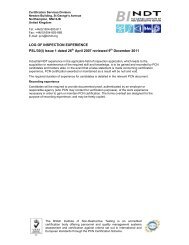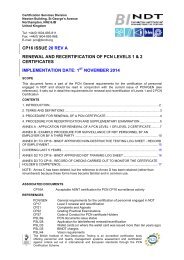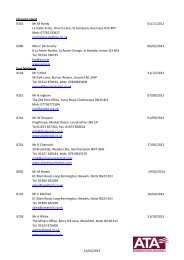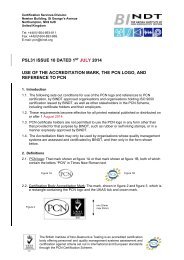Ultrasonic Imaging of Electrofusion Welded Polyethylene ... - BINDT
Ultrasonic Imaging of Electrofusion Welded Polyethylene ... - BINDT
Ultrasonic Imaging of Electrofusion Welded Polyethylene ... - BINDT
You also want an ePaper? Increase the reach of your titles
YUMPU automatically turns print PDFs into web optimized ePapers that Google loves.
<strong>Ultrasonic</strong> <strong>Imaging</strong> <strong>of</strong> Electr<strong>of</strong>usion <strong>Welded</strong> <strong>Polyethylene</strong> PipesEmployed in Utilities IndustryArjun Prakash TK 1, 2 , Richard L O’Leary 1 , and Anthony Gachagan 11 Centre for <strong>Ultrasonic</strong> Engineering, University <strong>of</strong> StrathclydeGlasgow, G1 1XW, UKPhone: +44 (0) 141 548 4019Fax: +44 (0)141 548 2950E-mail: arjun.tk@eee.strath.ac.ukKevin Ross 2 , Edward Clutton 22 Impact SolutionsGrangemouth, FK3 9XH, UKAbstractElectr<strong>of</strong>usion welding (EFW) is a widely used technique for joining polyethylene pipesin the oil, gas and water industry. Like many welding and joining methods, the jointscreated by EFW can exhibit a range <strong>of</strong> flaw types that can be attributed to processvariables such as: poor preparation <strong>of</strong> the parent material, contamination <strong>of</strong> the weldsurfaces prior to welding and operator and/or equipment failure during the weldingprocess. This paper describes ultrasonic testing using 128-channel linear array with aDYNARAY system to acquire data from a range <strong>of</strong> joints created using EFW. Thesamples were created in the laboratory with a range <strong>of</strong> defects that represent thosecommonly observed in the field. The samples were subsequently destructively testedusing tensile testing <strong>of</strong> the coupling-pipe interface. Good corroboration was achievedbetween the observed weld quality from the ultrasonic data and the weld strengthdetermined by the destructive testing.1 IntroductionHigh Density Poly Ethylene (HDPE) is used to transport a variety <strong>of</strong> materials such aspotable water, waste water, chemicals, slurries, hazardous wastes, compressed gases etc(1) . Some <strong>of</strong> the properties which make it an attractive option as a piping material are thelow installation and maintenance costs, chemical inertness, flexibility, fatigue resistanceand a smooth internal surface which gives excellent hydraulic efficiency (2) .The most common methods <strong>of</strong> joining <strong>Polyethylene</strong> pipes are the butt fusion weldingand electr<strong>of</strong>usion welding (EFW). The current discussion will be limited to the EFWtechnique where pipes are inserted into a polyethylene coupling which has an embeddedwire for resistance heating (See Figure 1). A voltage is applied across the inputterminals for duration equal to the Specified Fusion Time (SFT) and then allowed tocool. The duration may vary depending on coupling type and will be specified by themanufacturer. The procedure for EFW (based on the Water Industry Standards (3) , 2002)can be summarised as: pre-joint checks, preparation <strong>of</strong> the pipe surface, joint assemblyand clamping, fusion cycle and visual joint checks on completion <strong>of</strong> the fusion cycle.
These steps involve inherent operator and/or equipment dependence which ultimatelyinfluence weld quality.Figure 1: (Left) Pipe coupling assembly (Right) Cross-sectional schematicPreviously Shin et al (4) and Caravaca et al (5) have reported the use <strong>of</strong> B-Scans to detectdefects in electr<strong>of</strong>usion welds. Shin et al (4) describes the use <strong>of</strong> this technique to detectan overheated joint based on wire dislocation, defect due to soil inclusion and animperfect joint. Caravaca et al (5) describes an immersion inspection technique to detectdefects due to lack <strong>of</strong> penetration, lack <strong>of</strong> fusion and reduced heating time which werecorroborated with a crushing decohesion test.This paper will describe the use <strong>of</strong> a 5MHz, 128 element array for the inspection <strong>of</strong>EFW samples. A range <strong>of</strong> welds were created to simulate defects due to:• Surface contamination: Particulate surface contamination (with different particletypes and sizes), and oliferous surface contamination,• Errors in heating cycle (overheating, insufficient heating and two fusion cycles)• Misalignment <strong>of</strong> pipes in the coupling.The results from B-Scan inspection <strong>of</strong> the created samples are presented whichdemonstrates the capability <strong>of</strong> the technique to detect variability from a standard weld.The B-Scan data is then corroborated with the data obtained from a destructive testing<strong>of</strong> the inspected sample which gives both a quantitative and qualitative evaluation <strong>of</strong> theweld strength based on the observed peak Load/Width and the failure moderespectively. A probe carriage design with position encoding and adaptability toinspection scenarios involving different pipe dimension is also described.2
2 Experiments and Results2.1 <strong>Ultrasonic</strong> characterisation <strong>of</strong> PE80 and PE100The velocity and attenuation in two grades <strong>of</strong> polyethylene commonly used in pipes –PE80 and PE100 were studied using the non-contact through transmission method (6) .The transmitter and a receiver transducer were separated by a liquid coupling medium(water). The material to be characterised is placed between a transmitter receiver pairsuch that the sound waves travel through the specimen before reaching the receiver. (6)The correlation technique is used to find the value <strong>of</strong> time difference between thetransmitted and reference waves which is substituted in the equation for longitudinalvelocity. This method was carried out for a range <strong>of</strong> temperatures from 20 °C to 60 °C(See Figure 2).Figure 2: Plot <strong>of</strong> longitudinal velocity values for PE 80 and PE100 for differenttemperaturesThe values obtained from the non-contact method showed good correlation with thevalues obtained from the contact through transmission method (where transducers wereplaced in contact with the sample). The non-contact method was also used to determinetransverse velocity and attenuation characteristics <strong>of</strong> PE80 and PE100 for differenttemperatures.2.2 Preparation <strong>of</strong> sample defectsA range <strong>of</strong> electr<strong>of</strong>usion weld samples for pipe diameter 110 mm and 125 mm werecreated to simulate common defects that could occur in the field. These include:(a) Defects due to incorrect heating cycle - Overheated and insufficiently heatedsamples were created by varying the time for which voltage is applied across thecoupler terminals. An invalid double weld was also created by carrying out the3
welding process once for the SFT and then carrying out another weld for halfthe SFT once cold.(b) Surface contaminationbefore inserting into the coupling and staring the welding processcontaminants that were used include water, silicone grease,kaolin (
Figure 4: Carriage for manipulating the array along the inspection surfaceIn the results presented, a contact inspection methodology was used; with gelfacilitating the energy coupling into the sample. The disadvantage <strong>of</strong> this method is theinaccessibility <strong>of</strong> some areas such as the manufacturer labelling and the tapered ends.However, from the results obtained, it was observed that despite the reduced inspectionarea, sufficient data was available for defect detection.2.4 Analysis <strong>of</strong> B-Scan dataFigure 5 shows the B-Scan image <strong>of</strong> a standard weld next to an actual cross-section.The standard weld was produced by adhering to the SFT prescribed by the couplingmanufacturer and following the practices prescribed by Water Industry Standards (3) .In the B-Scan image, the wires and the central cold zone are visible as strongreflections. Pipe inner wall can be observed below the heating wires. The Eigen Line (8)also referred to as the Heat Affected Zone (5) appears as a weak reflection above thewires and indicates the extent <strong>of</strong> heat input to the weld. This is the boundary <strong>of</strong> theregion around the heating wires where polyethylene exists in the molten state during thewelding process. Reason for the existence <strong>of</strong> the Eigen line has been attributed to theformation <strong>of</strong> voids at the solid-liquid interface (8) . Shi et al (8) have shown that thedistance between heating wires and Eigen line follow an approximately linearrelationship with the welding time. If this distance is known for a correct heating cycle,variance in the heat input into the system can be determined based on the Eigen lineposition observed in the weld being inspected.5
Figure 5 (Right) B-Scan <strong>of</strong> a standard weld (Top Left) Cross-section <strong>of</strong> anelectr<strong>of</strong>usion weld (Bottom left) Region <strong>of</strong> the cross-section visible in the B-ScanFigure 6 to Figure 11 shows sections <strong>of</strong> B-Scans acquired from the sample defects,which can be compared to the standard weld result shown in Figure 5. In the samplewhich was welded twice (Figure 6) two Eigen lines are visible. In the B-Scan <strong>of</strong> theweld for which the fusion time was restricted to 0.6 times the SFT (Figure 7), the Eigenline is much closer to the heating wires. For the weld for which the fusion time wastwice the SFT (Figure 8), the Eigen line is further away from the heating wire, and inaddition the heating wires are displaced from their original position and reflections areobserved from between the wires due to material degradation. In Figure 9, for themisaligned weld, strong reflections from beneath the wires indicate a lack <strong>of</strong> fusion.Similarly, lack <strong>of</strong> fusion caused due to oliferous contaminant (Silicone grease) andparticulate surface contaminant (Talc with particle size
Figure 6: Fusion cycle carried out twiceFigure 7: Insufficiently heated (fusiontime = 0.6*SFT)Figure 8: Overheated (fusion time = 2*SFT)Figure 9: Weld carried out with pipesmisaligned7
Figure 10: Oliferous surfacecontaminant (Silicone Grease)Figure 11: Particulate surfacecontaminant - Talc (
Figure 13 shows the mean load/width value obtained for the samples described insection 2.4 and the error bars indicate the standard deviation. It can be seen that theweld fused at 0.6*SFT does not show a significant overall reduction in strength despitea large standard deviation. This could be attributed to the tolerance levels associatedwith the amount <strong>of</strong> heat required for maximum weld strength. All other samples show asignificant reduction in strength.Figure 13: Mean values <strong>of</strong> Load/Width obtained for different welds during thedestructive testingA qualitative assessment <strong>of</strong> the weld strength can be carried out from the type <strong>of</strong> failureobserved during the tensile test (See Figure 14). For a good weld, failure involvedsignificant drawing <strong>of</strong> the material between the wires and is referred to as a ductilefailure and was observed in the standard weld. Brittle failure (or a mix <strong>of</strong> both brittleand tensile failure) was observed in poor welds characterised by very little drawing <strong>of</strong>the material and failure occurs at a much lower load.Figure 14: Example <strong>of</strong> (Left) ductile failure in the standard weld sample and(Right) brittle failure in the sample with surface contamination (soil)9
3 ConclusionsUsing the B-Scan imaging technique, it was possible to detect the majority <strong>of</strong> defectswhich can be introduced into electr<strong>of</strong>usion welds. Detection <strong>of</strong> particulate contaminantscan be challenging in some scenarios where the size <strong>of</strong> the inclusion is much lesser thanthe inspection wavelength. In addition to the 110 and 125 mm pipe samples, thistechnique was also successfully applied to two real-world welds (75 mm and 180 mmdiameter) which had failed in the field; and is expected to be scalable to other pipedimensions.AcknowledgementsKnowledge Transfer Partnership (KTP) and the West <strong>of</strong> Scotland KTP centre forsupporting this project with Impact Solutions, Grangemouth.References1. ‘High-Density <strong>Polyethylene</strong> Pipe Systems: Meeting the challenges <strong>of</strong> the 21stCentury’, Plastics Pipe Institute, www.plasticpipe.org, [online], Available:http://www.plasticpipe.org/pdf/high_density_polyethylene_pipe_systems.pdf2. ‘Second Edition Handbook <strong>of</strong> PE Pipe’, Plastics Pipe Institute, Chapter 1-Introduction, [online], Available: http://plasticpipe.org/publications/pe_handbook.html3. ‘Specification for the Fusion Jointing <strong>of</strong> <strong>Polyethylene</strong> Pressure Pipeline SystemsUsing PE80 and PE100 materials’, WIS 4-32-08, Issue 3, April 2002.4. H. J. Shin, Y. H. Jang, J. R. Kwan, and E. J. Lee, ‘Nondestructive Testing <strong>of</strong> FusionJoints <strong>of</strong> <strong>Polyethylene</strong> Piping by Real Time <strong>Ultrasonic</strong> <strong>Imaging</strong>’, NDT.net, Vol 10, No3, March 2005, ISSN: 1435-4934.5. D S Caravaca, C Bird, and D Kleiner, ‘<strong>Ultrasonic</strong> phased array inspection <strong>of</strong>electr<strong>of</strong>usion joints in polyethylene pipes’, Insight Vol 49, No 2, pp 83-86, February2009.6. O’Leary, R.L., ‘An Investigation into the Passive Materials Utilised within theConstruction <strong>of</strong> Piezoelectric Composite Transducers’, Ph.D. Thesis, University <strong>of</strong>Strathclyde, Glasgow, Scotland, UK (2003).7. ‘Introduction to phased array ultrasonic technology applications’, R/D Techguideline, Olympus NDT, ISBN 0-9735933-0-X.8. J.S.J Zheng, W. Guo, P. Xu, Y. Quin, Shangzhi Zuo, ‘A model for predictingTemperature <strong>of</strong> Electr<strong>of</strong>usion Joints <strong>of</strong> <strong>Polyethylene</strong> Pipes’, Journal <strong>of</strong> Pressure VesselTechnology, pp 061403-1 – 061403-8, Vol 131, December 2009.10




